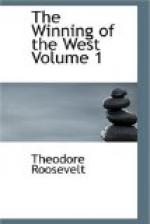A wedding was always a time of festival. If there was a church anywhere near, the bride rode thither on horseback behind her father, and after the service her pillion was shifted to the bridegroom’s steed.[37] If, as generally happened, there was no church, the groom and his friends, all armed, rode to the house of the bride’s father, plenty of whisky being drunk, and the men racing recklessly along the narrow bridle-paths, for there were few roads or wheeled vehicles in the backwoods. At the bride’s house the ceremony was performed, and then a huge dinner was eaten, after which the fiddling and dancing began, and were continued all the afternoon, and most of the night as well. A party of girls stole off the bride and put her to bed in the loft above; and a party of young men then performed the like service for the groom. The fun was hearty and coarse, and the toasts always included one to the young couple, with the wish that they might have many big children; for as long as they could remember the backwoodsmen had lived at war, while looking ahead they saw no chance of its ever stopping, and so each son was regarded as a future warrior, a help to the whole community.[38] The neighbors all joined again in chopping and rolling the logs for the young couple’s future house, then in raising the house itself, and finally in feasting and dancing at the house-warming.
Funerals were simple, the dead body being carried to the grave in a coffin slung on poles and borne by four men.
There was not much schooling, and few boys or girls learnt much more than reading, writing, and ciphering up to the rule of three.[39] Where the school-houses existed they were only dark, mean log-huts, and if in the southern colonies, were generally placed in the so-called “old fields,” or abandoned farms grown up with pines. The schoolmaster boarded about with the families; his learning was rarely great, nor was his discipline good, in spite of the frequency and severity of the canings. The price for such tuition was at the rate of twenty shillings a year, in Pennsylvania currency.[40]




